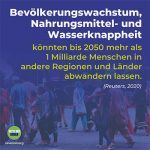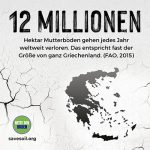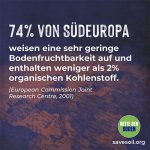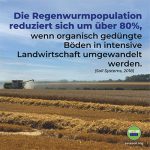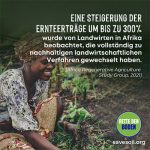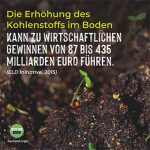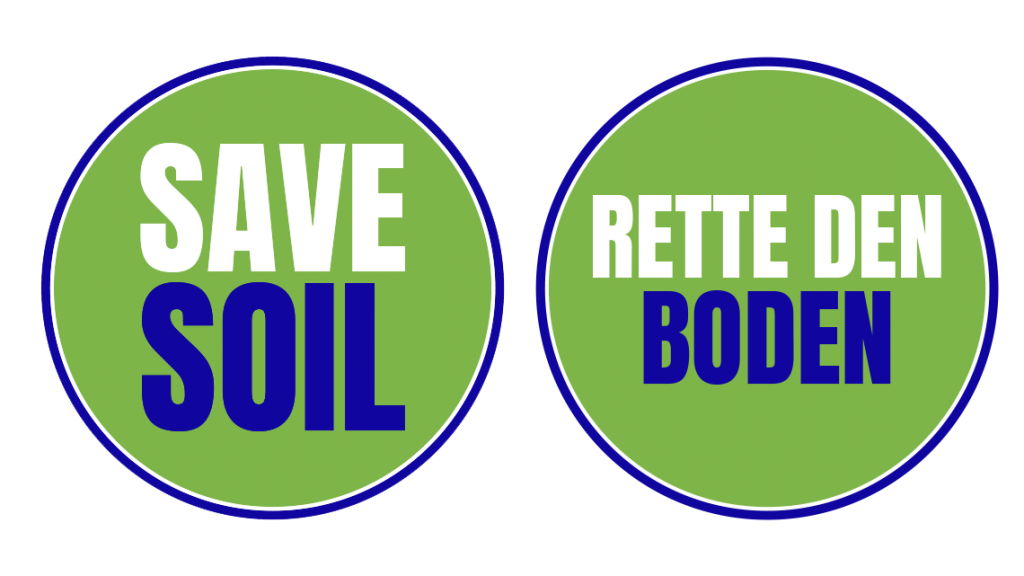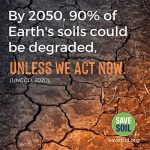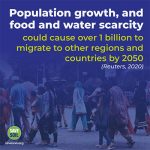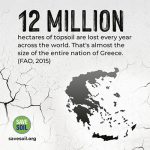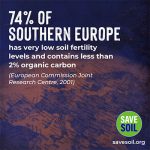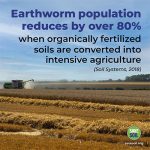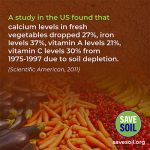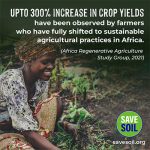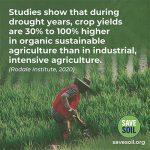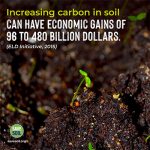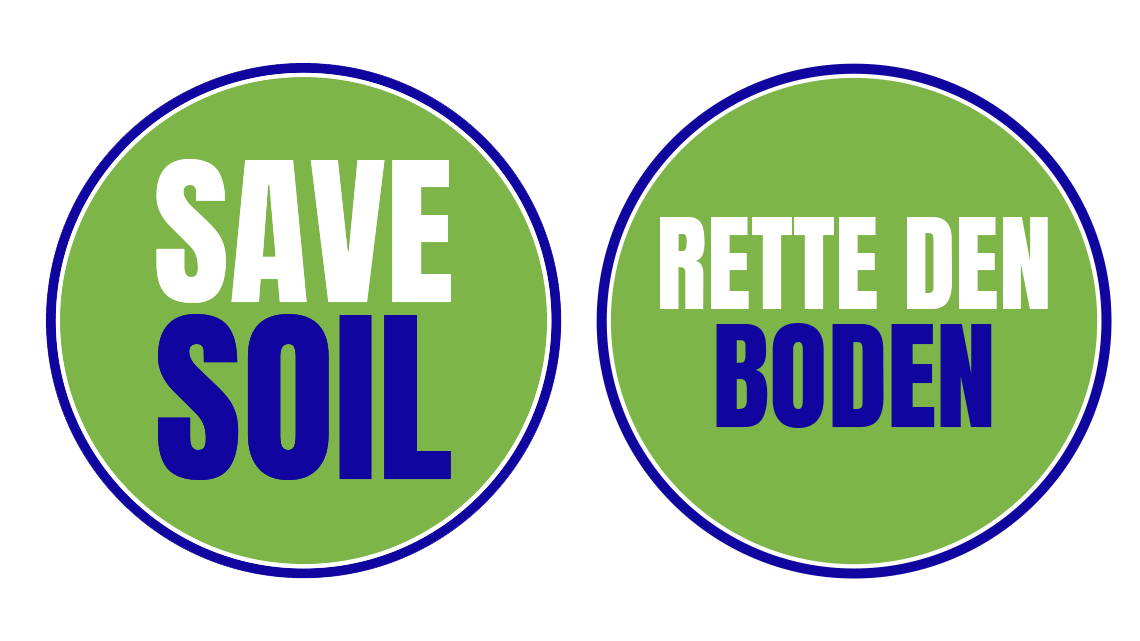
Save the Soil to save the Environment
“Save the Soil to save the Environment” – Über die Magie des Bodens oder wie Tod in Leben verwandelt wird
– in Zusammenarbeit mit unserem Nachhaltigkeitsreferat –
Der Boden stirbt
In den letzten vierzig Jahren sind vierzig Prozent des Mutterbodens der Welt verloren gegangen. Zum heutigen Tage sind bereits 52 % der landwirtschaftlichen Böden degradiert.
Nach Angaben der Vereinten Nationen (UN) reicht der Boden nur noch für etwa 80 bis 100 Ernten, d.h. für weitere 45 bis 60 Jahre Landwirtschaft. Danach werden wir nicht mehr genug fruchtbaren Boden haben, um Nahrungsmittel zu produzieren. Das Leid, welches wir damit in der Welt entfalten werden, ist kaum vorstellbar.
74 % der Böden in Südeuropa stehen schon heute mit einem organischen Kohlenstoffanteil von unter 2 % kurz vor der Degradation. Das heißt sie weisen eine sehr geringe Bodenfruchtbarkeit auf. In Spanien ist bereits die Hälfte der Böden desertifiziert. Der organische Kohlenstoffanteil liegt dabei unter einem Prozent!
FACT: Ein Teelöffel voll Erde enthält mehr lebende Organismen als es Menschen auf dem Planeten gibt.
Warum müssen wir unsere Böden retten?
Nach den Ozeanen ist der Boden die größte Kohlenstoffsenke der Welt. Der Boden, sofern er reich an organischen Bestandteilen ist, bindet und speichert CO2. Auf der anderen Seite wird genau diese Menge an CO2 in die Atmosphäre freigesetzt, wenn man den Boden umpflügt und in Folge austrocknet.
Wir brauchen Böden, die reich an organischen Bestandteilen sind und das Pflanzenleben unterstützen, damit die übermäßigen Kohlenstoffemissionen des vergangenen Jahrhunderts gebunden werden können.
Der Boden ist darüber hinaus der größte Wasserspeicher des Planeten. 90 % des für die Landwirtschaft benötigten Wassers stammt aus dem Boden.
Die Bodenvielfalt spielt eine große Rolle bei der Reinigung von Wasser, das in den Boden sickert. Reichhaltige Böden sorgen nicht nur für einen ausreichenden Grundwasserspiegel, sondern sind auch ein wesentlicher Faktor für die Gesundheit tropischer Flusssysteme – der Schlüssel zur Lösung der Wasserkrise in vielen Teilen der Welt.
Ein gesunder Boden verhindert auch die gefährlichen Zyklen von Überschwemmungen und Dürren, von denen so viele Regionen der Welt betroffen sind.
Was bedeutet Boden?
Der Boden ist die Grundlage für fast alles Leben auf diesem Planeten. Er ist ein komplexes, symbiotisches System aus organischen Stoffen, Mineralien, Gasen, Flüssigkeiten und lebenden Organismen, die zusammen das Leben erhalten. Ohne organische Bestandteile in Form von Humus und lebenden Organismen und Mikroben wird der Boden zu leblosem Sand.
Teste dein Wissen über den Boden – Hier geht’s zum Boden Quiz: https://www.consciousplanet.org/de/soil
Was können wir jetzt tun?
Save Soil (Rette den Boden) ist eine globale Bewegung, die von Sadhguru ins Leben gerufen wurde, um die Bodenkrise anzugehen. Indem Menschen aus der ganzen Welt zusammenkommen, können wir uns gemeinsam für die Gesundheit des Bodens einsetzen. So unterstützen wir die Führungspersönlichkeiten aller Nationen dabei, nationale Strategien und Maßnahmen zur Erhöhung des organischen Anteils in kultivierbaren Böden einzuführen.
Die Lösung ist gar nicht so schwierig. Über effektive politische Weichenstellungen und individuell angepasstes Verhalten, lässt sich der organische Anteil im Boden wiederherstellen. Indem der Boden durch Vegetation beschattet und mit Pflanzenstreu und tierischen Abfällen angereichert wird, lässt sich ein gesunder Anteil von mindestens 3-6 % im Boden herstellen.
Wenn wir jetzt handeln, kann diese Krise durch politische Maßnahmen zum Schutz der Bodengesundheit auf der ganzen Welt wirksam umgedreht werden. Isolierte Einzelmaßnahmen reichen nicht mehr aus, um die Situation zu ändern. Um die Gesundheit der Böden zu gewährleisten, bedarf es der kollektiven Beteiligung aller Bürgerinnen und Bürger.
Sei deswegen auch du dabei!
Folge der Save Soil Initiative auf Instagram (https://www.instagram.com/consciousplanet/), erzähle deinen Freund*innen von der Problematik oder schreibe einen Brief an deine Lokalpolitiker*innen (https://www.consciousplanet.org/de/letters).
Es gibt zahlreiche Wege das Movement zu unterstützen. Lass uns gemeinsam die Aufmerksamkeit auf unsere Böden lenken. So können wir langfristig unsere Lebensgrundlagen bewahren.
Weitere Informationen findest du im Internet:
- Save Soil Website: https://www.consciousplanet.org/de
- Save Soil im Videoformat: https://youtu.be/hyT-6qiubd0
- Hilfreiches Toolkit um Save Soil zu unterstützen: https://www.consciousplanet.org/toolkit
- ACTION NOW: https://www.consciousplanet.org/de/action-now
HANDLE JETZT! MAKE IT HAPPEN!
Quellen:
- https://isha.sadhguru.org/global/en/wisdom/article/save-the-soil-revitalization-methods
- https://www.consciousplanet.org/de/soil
“Save the Soil to save the Environment” – About the Magic of Soil or How Death is Turned into Life
– in cooperation with our sustainability department –
The soil is dying
Forty percent of the world’s topsoil has been lost in the last forty years. As of today, 52 % of agricultural soils are already degraded.
According to the United Nations (UN), there is only enough soil for about 80 to 100 harvests, i.e. for another 45 to 60 years of agriculture. After that, we will no longer have enough fertile soil to produce food. The suffering we will unleash on the world is almost unimaginable.
74 % of the soils in Southern Europe are already on the verge of degradation with an organic carbon content of less than 2 %. This means they have very low soil fertility. In Spain, half of the soils are already decertified. The organic carbon content is less than one percent!
FACT: A teaspoonful of healthy soil contains more living organisms than there are humans on the planet.
Why do we need to save our soils?
After the oceans, soil is the world’s largest carbon sink. Soil, if it is rich in organic matter, binds and stores CO2. On the other hand, this is exactly the amount of CO2 that is released into the atmosphere when soil is ploughed up and subsequently dries out.
We need soils that are rich in organic matter and support plant life so that the excessive carbon emissions of the past century can be sequestered.
Soil is also the planet’s largest water reservoir. 90 % of the water needed for agriculture comes from the soil.
Soil diversity plays a major role in purifying water that seeps into the soil. Rich soils not only ensure adequate groundwater levels but are also a key factor in the health of tropical river systems – the key to solving the water crisis in many parts of the world.
Healthy soil also prevents the dangerous cycles of floods and droughts that affect so many regions of the world.
What does soil mean?
Soil is the basis for almost all life on this planet. It is a complex, symbiotic system of organic matter, minerals, gases, fluids and living organisms that together sustain life. Without organic matter in the form of humus and living organisms and microbes, soil becomes lifeless sand.
Test your knowledge about soil – Go to the Soil Quiz: https://www.consciousplanet.org/de/soil
What can we do now?
Save Soil is a global movement started by Sadhguru to address the soil crisis. By bringing together people from all over the world, we can work together for soil health. In this way, we are supporting leaders of all nations to put in place national strategies and policies to increase the organic content in cultivable soils.
The solution is not so difficult. Through effective policies and individualised behaviour, soil organic matter can be restored. By shading the soil with vegetation and enriching it with plant litter and animal waste, a healthy level of at least 3-6 % can be achieved in the soil.
If we act now, this crisis can be effectively reversed through policies to protect soil health around the world. Isolated individual measures are no longer enough to change the situation. Ensuring soil health requires the collective participation of all citizens.
That’s why you should be part of it too!
Follow the Save Soil Initiative on Instagram (https://www.instagram.com/consciousplanet/), tell your friends about the issue or write a letter to your local politicians (https://www.consciousplanet.org/de/letters).
There are many ways to support the movement. Let’s work together to draw attention to our soils. In this way we can preserve our planetary mother in the long term.
You can find more information on the internet:
- Save Soil homepage: https://www.consciousplanet.org/de
- Save Soil in video format: https://youtu.be/hyT-6qiubd0
- Useful Toolkit to support Save Soil: https://www.consciousplanet.org/toolkit
- ACTION NOW: https://www.consciousplanet.org/de/action-now
ACT NOW! LET’S MAKE IT HAPPEN!
Sources:

